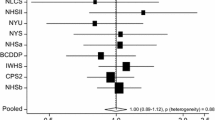Abstract
Objective: To evaluate the association between dietary intake of carotenoids and vitamin A and the incidence of ovarian cancer.
Methods: We conducted a population-based case–control study of ovarian cancer in Massachusetts and Wisconsin. Incident cases diagnosed between 1991 and 1994 were identified through statewide tumor registries. We selected community controls at random from lists of licensed drivers and Medicare recipients; 327 cases and 3129 controls were included in the analysis. Data were collected by telephone interview, which included an abbreviated food and supplement list to quantify typical consumption of carotenoids (lutein/zeaxanthin, alpha-carotene, beta-carotene), retinol and total vitamin A at 5 years prior to diagnosis in cases, or to a comparable reference date in controls. Results were adjusted for age, state, and other risk factors.
Results: Participants with the highest dietary intake of lutein/zeaxanthin (≥24,000 μg/week) experienced a 40% lower risk of ovarian cancer (95% CI = 0.36–0.99) compared to those with the lowest intake. Intake of alpha-carotene, beta-carotene, retinol and total vitamin A was unrelated to risk. Among foods, we observed non-significantly lower risks with high consumption of spinach, carrots, skim/lowfat milk and liver.
Conclusion: These results support previous findings suggesting an inverse relationship between carotenoid intake and ovarian cancer risk.
Similar content being viewed by others
References
Landis SH, Murray T, Bolden S, Wingo PA (1999) Cancer statistics, 1999. CA Cancer J Clin 49: 8-31.
Teneriello MG, Park RC (1995) Early detection of ovarian cancer. CA Cancer J Clin 45: 71-87.
Berek JS, Martinez-Masa O (1994) Molecular and biological factors in the pathogenesis of ovarian cancer. J Reprod Med 39: 241-247.
Byers T, Marshall J, Graham S, Mettlin C, Swanson M (1983) A case±control study of dietary and non-dietary factors in ovarian cancer. J Natl Cancer Inst 71: 681-686.
Slattery M, Schuman KL, West DW, French TK, Robison LM (1989) Nutrient intake and ovarian cancer. Am J Epidemiol 130: 497-502.
Tzonou A, Hsieh C-C, Polychronopoulou A, et al. (1993) Diet and ovarian cancer: a case-control study in Greece. Int J Cancer 55: 411-414.
Engle A, Muscat JE, Harris RE (1991) Nutritional risk factors and ovarian cancer. Nutr Cancer 15: 239-247.
Helzlsouer KJ, Alberg AJ, Norkus EP, Morris JS, Hoffman SC, Comstock GW (1996) Prospective study of serum micronutrients and ovarian cancer. J Natl Cancer Inst 88: 32-37.
Kushi LH, Mink PJ, Folsom AR, et al. (1999) Prospective study of diet and ovarian cancer. Am J Epidemiol 149: 21-31.
La Vecchia C, Decarli A, Negri E, et al. (1987) Dietary factors and the risk of epithelial ovarian cancer. J Natl Cancer Inst 79: 663-669.
Shu XO, Gao YT, Yuan JM, Ziegler RG, Brinton LA (1989) Dietary factors and epithelial ovarian cancer. Br J Cancer 59: 92-96.
Longnecker MP, Newcomb PA, Mittendorf R, Greenberg ER, Willett WC (1997) Intake of carrots, spinach, and supplements containing vitamin A in relation to risk of breast cancer. Cancer Epidemiol Biomarkers Prev 6: 887-892.
Titus-Ernstoff L, Egan KM, Newcomb PA, et al. (1998) Exposure to breast milk in infancy and adult breast cancer risk. J Natl Cancer Inst 90: 921-924.
Byers T, Marshall J, Fiedler R, Zielezny M, Graham S (1985) Assessing nutrient intake with an abbreviated dietary interview. Am J Epidemiol 122: 41-50.
Romieu I, Stampfer MJ, Stryker WS (1990) Food predictors of plasma beta-carotene and alpha-tocopherol: validation of a food-frequency questionnaire. Am J Epidemiol 131: 864-876.
Stryker WS, Salvini S, Stampfer MJ, Sampson L, Colditz GA, Willett WC (1991) Contributions of specific foods to absolute intake and between-person variation of nutrient consumption. J Am Diet Assoc 91: 172-178.
Chug-Ahuja JK, Holden JM, Forman MR, Mangels AR, Beecher GR, Lanza E (1993) The development and application of a carotenoid database for fruits, vegetables, and selected multi-component foods. J Am Diet Assoc 93: 318-323.
Serdula M, Coates RJ, Byers T, et al. (1993) Evaluation of a brief telephone questionnaire to evaluate fruit and vegetable consumption in diverse study populations. Epidemiology 4: 455-463.
Cooper GS, Sandler DP, Bohlig M (1999) Active and passive smoking and the occurrence of natural menopause. Epidemiology 10: 771-773.
Kato I, Toniolo P, Akhmedkhanov A, et al. (1998) Prospective study of factors influencing the onset of natural menopause. J Clin Epidemiol 51: 1271-1276.
Rosseau EJ, Davison AJ, Dunn B (1992) Protection by beta-carotene and related compounds against oxygen-mediated cyto-toxicity and genotoxicity: implications for carcinogenesis and anticarcinogenesis. Free Rad Biol Med 1992: 407-433.
Bendich A, Shapiro SS (1988) Effect of beta-carotene and canthaxanthin on the immune responses of the rat. J Clin Nutr 116: 2254-2262.
Krinsky N (1991) Effects of carotenoids in cellular and animal systems. Am J Clin Nutr 53: 238S-246S.
Moon RC (1994) Vitamin A, retinoids, and breast cancer. Adv Exp Med Biol 264: 101-107.
Kaplan LA, Lau JM, Stein EA (1990) Carotenoid composition, concentrations and relationships in various human organs. Clin Physiol Biochem 8: 1-10.
Behrman HR, Riley JC, Aten RF (1993) Reactive oxygen species and ovarian function. In: Adashi EY, Leung PCK, eds. The Ovary. New York: Raven Press, pp. 455-471.
Giovannucci E (1999) Tomatoes, tomato-based products, lycopene and cancer: a review of the epidemiologic literature. J Natl Cancer Inst 91: 317-331.
Willett WC (1998) Nutritional Epidemiology, 2nd edn. New York: Oxford University Press.
Author information
Authors and Affiliations
Rights and permissions
About this article
Cite this article
Bertone, E.R., Hankinson, S.E., Newcomb, P.A. et al. A population-based case–control study of carotenoid and vitamin A intake and ovarian cancer (United States). Cancer Causes Control 12, 83–90 (2001). https://doi.org/10.1023/A:1008985015927
Issue Date:
DOI: https://doi.org/10.1023/A:1008985015927




